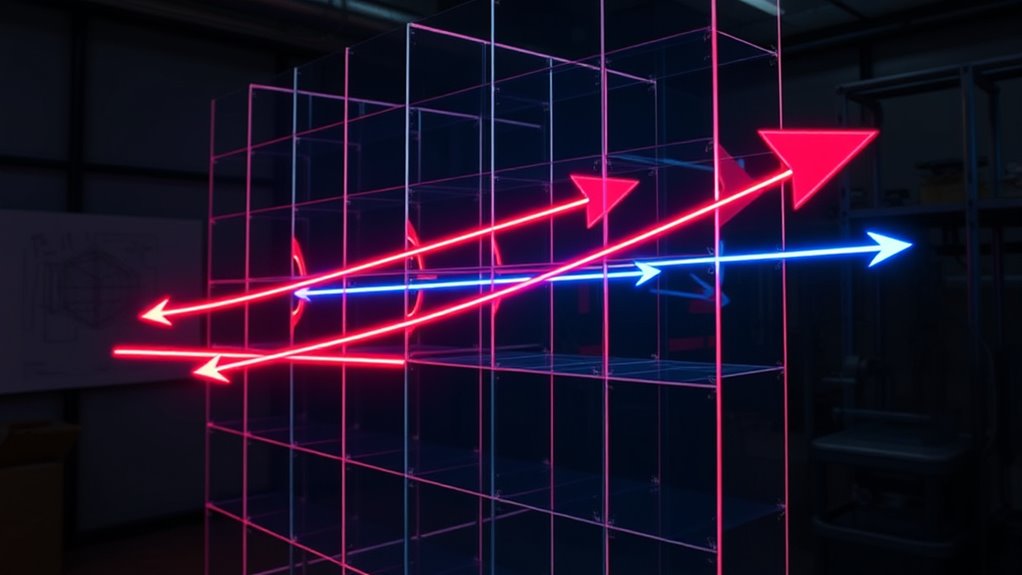Vectors are essential tools in physics and engineering that help you represent quantities with both magnitude and direction, such as forces and velocities. You can perform operations like addition, subtraction, and scalar multiplication to analyze how these quantities interact. Visualizing vectors in space makes complex problems clearer, especially in structures or motion. If you keep exploring, you’ll discover how vectors shape modern innovations and problem-solving techniques across various fields.
Key Takeaways
- Vectors represent quantities with magnitude and direction, fundamental for describing forces, velocities, and accelerations in physics and engineering.
- Vector operations such as addition, subtraction, and scalar multiplication enable analysis of combined forces and motion.
- Dot product helps determine the angle between vectors and projections, essential for force component analysis.
- Visualization of vectors as arrows supports understanding spatial relationships and behaviors in three-dimensional systems.
- In structural engineering, vectors analyze forces and moments to ensure safety, stability, and optimal load distribution in structures.
Understanding the Fundamentals of Vectors

To understand vectors, you need to grasp that they are quantities possessing both magnitude and direction. This dual nature makes vectors essential in physics and engineering. You can manipulate vectors through vector algebra, which includes operations like addition, subtraction, and scalar multiplication. These operations help you analyze forces, velocities, and other physical quantities efficiently. Vector calculus extends these concepts, allowing you to study how vectors change across space and time, which is crucial for understanding fields and gradients. Mastering these fundamentals will enable you to apply vectors confidently in various applications, from analyzing projectile motion to designing mechanical systems. Recognizing the importance of both magnitude and direction is key to leveraging vectors in real-world problem-solving and advancing your comprehension of complex phenomena. Additionally, understanding the contrast ratio can significantly improve the visual clarity of images in applications involving vectors, such as simulations and graphics rendering.
Mathematical Operations With Vectors

Building on your understanding of vectors’ fundamental properties, you can now explore how to perform various mathematical operations with them. Vector calculus provides tools to manipulate vectors, including addition, subtraction, and scalar multiplication. These operations follow straightforward rules: adding vectors combines their components, while scalar multiplication scales each component. The dot product is a key operation that measures how much two vectors point in the same direction. Calculated by multiplying corresponding components and summing the results, it results in a scalar. The dot product helps determine angles between vectors and projections, essential in physics and engineering applications. Mastering these operations allows you to analyze vector quantities more effectively and lays the foundation for understanding more complex vector calculus techniques. Understanding the properties of vectors is crucial for applying these operations correctly in various contexts.
Visualizing Vectors in Space

To understand vectors in space, you’ll need to learn how to represent them in three dimensions. Using spatial visualization techniques helps you see how vectors relate to each other and their surroundings. Mastering 3D vector representation makes complex problems much clearer and easier to solve. Incorporating visualization techniques can significantly enhance your understanding of spatial relationships.
3D Vector Representation
Visualizing vectors in space involves representing them as directed arrows that originate from a specific point, typically the origin. This visualization helps you understand their magnitude and direction. To do this effectively, you use vector notation, which assigns symbols like (vec{v}) to vectors. When working within coordinate systems, such as Cartesian coordinates, you can express vectors by their components along each axis. For example, a vector in 3D space can be written as (vec{v} = langle v_x, v_y, v_z rangle), showing how it extends in each direction. This notation simplifies calculations and makes it easier to visualize how vectors behave in different coordinate systems. By mastering this representation, you can analyze complex vector relationships in physics and engineering more clearly. Additionally, understanding how the vector components interact allows for more precise modeling of physical phenomena.
Spatial Visualization Techniques
Understanding how vectors appear in space enhances your ability to interpret their physical significance. Spatial visualization techniques help you grasp complex concepts like vector field visualization and 3D vector plotting. To improve your skills, consider these methods:
- Use 3D graphing tools to create accurate vector representations in space.
- Practice overlaying vectors on coordinate systems to see their directions and magnitudes clearly.
- Explore software that allows dynamic manipulation of vector fields, helping you understand flow patterns and interactions.
- Recognize that noise levels of modern heat pumps have been minimized through advanced technology, aiding in clearer visualization and analysis of vector fields in practical applications.
These techniques make it easier to interpret how vectors behave in real-world applications, whether in physics or engineering. Mastering spatial visualization boosts your ability to analyze vector quantities in three dimensions effectively.
Vectors in Classical Mechanics

In classical mechanics, vectors help you understand how forces affect motion. You’ll learn to break down these forces into components to analyze their effects accurately. This approach makes it easier to predict how objects move under various influences. Additionally, understanding water resistance is crucial when studying the motion of objects through fluids.
Force and Motion
Vectors are fundamental in describing force and motion in classical mechanics because they provide a complete representation of both magnitude and direction. Understanding vector magnitude helps you quantify the strength of a force, while vector addition allows you to find the resultant force when multiple forces act on an object. To analyze motion effectively, you should:
- Determine the vector magnitude of each force involved.
- Use vector addition to combine forces acting in different directions.
- Apply these concepts to calculate the net force and predict object acceleration.
- Recognize the importance of understanding force and motion in physics to analyze and solve real-world engineering problems.
Vector Components
When analyzing forces and motion, breaking down a vector into its components simplifies complex problems. Vector components allow you to perform component analysis, making it easier to solve for unknowns. You can split a vector into horizontal and vertical parts, usually along x and y axes. This process helps you understand how each force influences motion separately. Here’s a quick look:
| Vector | Component 1 | Component 2 |
|---|---|---|
| Force | Fx | Fy |
| Velocity | Vx | Vy |
| Accel | Ax | Ay |
| Displacement | Dx | Dy |
| Resultant | R_x | R_y |
Using vector components streamlines calculations and clarifies the effects of forces, making your analysis more precise and manageable. Recognizing the importance of vector components enhances your understanding of how forces contribute to motion in classical mechanics.
Application of Vectors in Structural Engineering

Structural engineers rely heavily on vectors to analyze forces and moments acting on buildings and bridges. By doing so, you can determine how material stress varies and how load distribution affects structural stability. This helps you:
- Calculate the magnitude and direction of forces within beams and columns.
- Assess stress points where material failure might occur.
- Optimize load paths to improve safety and efficiency.
- Understand the importance of transparency in affiliate relationships when sourcing materials or tools, ensuring ethical and informed choices.
Using vectors, you guarantee forces are accurately represented, enabling precise calculations of complex load interactions. This approach helps you identify critical areas needing reinforcement and distribute loads evenly across the structure. Ultimately, applying vectors in structural engineering enhances safety, durability, and performance of your designs.
Future Directions and Innovations Involving Vectors

Advancements in computational technology are driving innovative applications of vectors across physics and engineering, opening new possibilities for modeling and analysis. You’ll see vector-based algorithms becoming more sophisticated, enhancing simulations and data processing in complex systems. Quantum vector applications are also emerging, offering breakthroughs in quantum computing and information transfer. These innovations enable you to manipulate vectors at atomic scales, improving precision and efficiency in research. As hardware continues to evolve, you’ll be able to implement real-time vector calculations for dynamic systems. Future developments will likely integrate machine learning with vector-based algorithms, fostering adaptive solutions. Additionally, the integration of cold-pressed vegetable juice techniques into data processing could inspire novel approaches for managing high-dimensional data. Overall, these trends promise to expand vectors’ role, pushing the boundaries of what you can model, analyze, and innovate in physics and engineering.
Frequently Asked Questions
How Do Vectors Differ From Scalars in Real-World Scenarios?
In real-world scenarios, you notice that a scalar quantity like temperature or mass has only magnitude, while a vector involves both magnitude and direction. For example, if you walk 5 miles north, that’s a vector with a magnitude of 5 miles and a specific direction. Scalars lack direction, so they only tell you how much. Vectors give a complete picture, essential for understanding movement, forces, and other physical phenomena.
What Are the Limitations of Vector Applications in Complex Systems?
Dealing with the dilemmas of dimensional complexity, you find that vectors often falter in complex systems. You face formidable computational challenges, as calculations become cumbersome and convoluted. The limitations lie in managing multidimensional data and accurately modeling dynamic interactions. You might struggle to simplify these systems without sacrificing accuracy, making it difficult to harness vectors effectively in intricate, real-world scenarios where complexity exceeds straightforward solutions.
How Can Vector Calculus Be Applied to Modern Robotics?
You can use vector calculus to improve modern robotics by analyzing the robotic arm’s motion and optimizing its movement. It helps you perform precise motion planning, ensuring the arm moves efficiently and accurately. By calculating gradients and directional derivatives, you can control the arm’s trajectory better, avoid obstacles, and enhance its overall performance. This mathematical approach makes the robotic system more adaptable and capable of complex tasks.
In What Ways Do Vectors Influence Electromagnetic Field Design?
You influence electromagnetic field design through vectors by applying vector addition to model complex interactions, ensuring accurate field configurations. Vectors help you analyze the direction and magnitude of electromagnetic waves, guiding your designs for antennas and circuits. By understanding these vector principles, you can optimize wave propagation, reduce interference, and improve device performance, making your electromagnetic systems more efficient and effective.
What Emerging Technologies Rely Heavily on Vector Mathematics?
You’re exploring emerging technologies that heavily rely on vector mathematics. Quantum computing uses vectors to represent quantum states and perform complex calculations. Autonomous navigation depends on vectors to determine directions, velocities, and positions in real-time. These technologies harness vector math to improve efficiency, accuracy, and capabilities, driving innovation in fields like computing and transportation. By mastering vectors, you enable advancements that shape the future of technology and its applications.
Conclusion
By understanding vectors, you can analyze forces, motion, and structures effectively. Imagine designing a bridge where vectors help you calculate load distributions and stress points, ensuring safety and stability. As you explore future innovations, like autonomous vehicles relying on vector-based navigation, you’ll see how this fundamental concept shapes technology. Embracing vectors open up countless possibilities across physics and engineering, empowering you to solve complex problems with clarity and precision.






